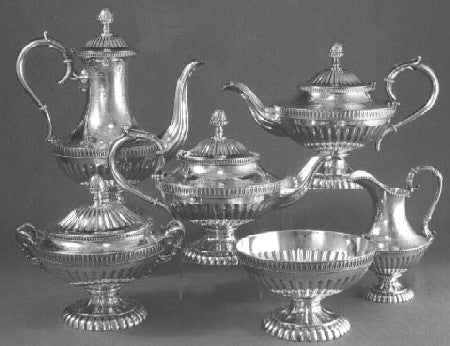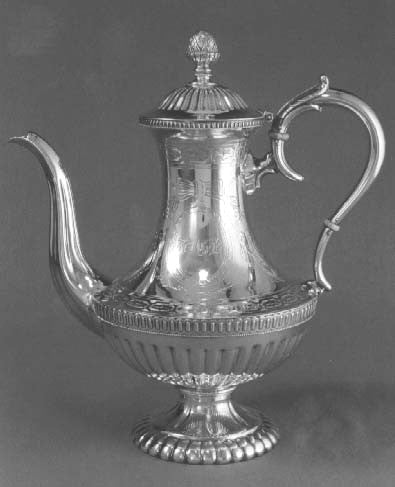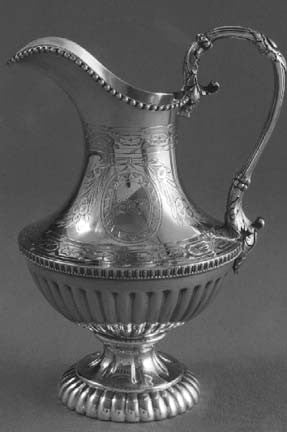Your Cart is Empty
FREE standard shipping to the continental US.
From the November/December 1998 issue of

John R. Wendt has proven to be one of the most important, yet elusive, of all nineteenth century American silversmiths. Due to the fact that most of his work was marked only by its retailers, his pieces can be difficult to identify. Although his years in New York have been well documented and much of his flatware identified, little is known of his early Boston years.
The Boston partnership of Augustus Rogers and John Rudolph Wendt has been identified in several early silver references, including Hollis French's A Silver Collector's Glossary and a List of Early American Silversmiths and their Marks,(1) but in all instances the partnership is dated to ca. 1850, and no marks are represented.

The more recent scholarship of D. Albert Soeffing and Diana Cramer offers the most complete look at his early years. Based on public records such as city directories, tax rolls, and business records, this scholarship is informative but tells us little about the actual products of the firm.
Boston City Directories(2) first mention John R. Wendt in 1850 and list his occupation as "silver chaser." By 1853 he had formed a partnership, Rogers & Wendt, with Augustus Rogers, an established Boston silversmith. This partnership lasted until 1860,

when Wendt was lured to New York by Ball, Black & Co., the important jewelry firm, to form a close manufacturer-retailer relationship similar to the relationship John C. Moore was developing with Tiffany & Co.
The six-piece tea and coffee service pictured here is a product of the Rogers and Wendt partnership (Fig. 1). It bears the incuse R. & W. maker's mark of Rogers & Wendt (Fig. 2) along with Boston , Jones, Shreve, Brown & Co., and the "eagle/shield" mark commonly associated with the later Shreve, Crump and Low.(3) Rogers & Wendt marked only some of their silver with a maker's mark, as evidenced by a sugar bowl of identical form but without the chased ornamentation, now in a private collection, which is marked only Jones, Shreve, Brown & Co. We believe this is the first time the
Rogers & Wendt mark has been published.
An important example of Boston silver; this tea and coffee service descended in the Binney-Newberry family of Boston and Providence, RI. Purchased in 1857 at the fashionable Boston jeweler Jones, Shreve, Brown & Co., this service was a central part of the wedding silver when Elizabeth Goddard Binney married Barnes Newberry in 1857. Comprising a coffeepot, two teapots, a covered sugarbowl, cream jug, and waste bowl, this is a large tea and coffee service for the 1850s, before the discovery of the Comstock Lode and the relatively inexpensive silver of the late nineteenth century. The high level of ornamentation on this service was a costly addition that is even more impressive in light of the economic contraction of the mid 1850s.
Made during a period often associated with the floral excesses of the "Rococo Revival," the design of the service is strikingly classical. The um-shaped pots are fluted in their hemispherical bodies, pedestal feet, and lids (Fig. 3). Ovals and beading on die-rolled bands encompass the midsections and lid rim rests. Each foot terminates in bold reeding. The domed lids terminate in artichoke finials, a classical Roman motif. Acanthus leaves on the handles continue the classical motifs. On the sugar bowl, each handle

is a cast acanthus leaf and bud that opens into two scrolling vines that separate, loop, and then attach to the bowl at the die-rolled molding (Fig. 4). Similarly, high quality castings of acanthus leaves are incorporated in the handle of the creamer (Fig. 5).
Most exceptional, however, is the hand-chasing of bows, floral garlands, and paterae in an ornate neoclassical style based on the designs of Robert Adam, the Scottish architect and designer popular during the late eighteenth century. This chasing enlivens every plain surface, making the set highly ornate. In 1856 the Rogers & Wendt shop employed about forty people,(4) and it is fun to speculate that Wendt, himself an accomplished chaser worked on this service.
Although little is known today about John R. Wendt and his formative years in Boston, he appears to have been well known over a century ago. In Leading Pursuits and Leading Men (1856), Edwin T. Freedley devoted nearly a page to the partnership of Augustus Rogers and John Wendt:
ROGERS & WENDT, 4 Court Avenue Boston, are said to be the largest exclusive manufacturers of hollow silver-ware in Boston, and probably in the Union. This concern was established in 1840 by Mr. Rogers, who previously, for a number of years, had been a prominent silversmith in the city of New York. Possessing more experience than capital, he commenced at the comer of Court Avenue and Washington Streets in the "city of notions," with but three assistants, and confining his operations almost entirely to the manufacture of plain hollow-ware. At the end of ten years, he found not only constant employment for six men, but that an extended business required more room, which determined a removal to his present location. A short time previously, he had associated with him Mr. J. R. Wendt, a German, reputed to be one of the best designers and chasers in the art.
Messrs. Rogers & Wendt now manufacture every variety of silver hollow-ware, tea -service, urns, pitchers, goblets, &c., from the plainest to the costliest and most highly ornamented. One of the firm has recently returned from a tour through the manufacturing cities of Europe studying the latest designs and improvements of the Old World to introduce them in the New. Employing about forty select workmen, and possessing every facility of machinery, &c. for conducting their business, they are prepared to receive orders from all parts of the United States, and execute them with fidelity and dispatch.
While Freedley's tone seems more promotional than objective, the convergence of known objects from the partnership and this contemporary account give us several insights into the firm and its products:
It is easy to imagine a young and talented German silver chaser and an established producer of "plain" hollowware making excellent partners. For Augustus Rogers, the successful partnership with Wendt must have seemed the perfect culmination of a long working career. The young John R. Wendt, as junior partner in a large wholesaling firm, was able to make the business connections he relied on for the rest of his important career.
Much still needs to be learned about John R. Wendt, his productive early years in Boston, the silver he made in partnership with Augustus Rogers, and the role he played in the German community at large.6 It appears that the Rogers & Wendt partnership produced a substantial amount of hollowware. Hopefully, with the publication of this mark, we can identify more silver made by the firm and ultimately learn more about the people who made it.
Mark McHugh and Spencer Gordon together form Spencer Marks, dealers of fine antiques , silver, and books about antiques. They can be reached at (508) 668-6990 or at their Web site www.spencermarks.com, or by e-mail at sg3@worldnet.att.net.
ENDNOTES
BIBLIOGRAPHY
Adams, George. The Boston Director for the Year ,embracing the City Record, a general Directory of the Citizens, and a Business Directory, with an Almanac, from July to July. Published annually in Boston by George Adams.
Cramer, Diana. 'John R. Wendt of Boston and New York, Part I." Silver Magazine, May-June 1992, pp. 12-13.
'John R. Wendt, the Flatware." Silver Magazine, July-August 1992, pp. 18-26.
'John R. Wendt and Associates: New Discoveries." Silver Magazine, November-December 1992, pp. 20-28.
Fredyma, Paul and Marie Louise. Directory of Boston Silversmiths and Watch and Clockmakers. Hanover, N.H.: Right Printing Co., 1975.
Freedley, Edwin T. Leading Pursuits and Leading Men. Philadelphia: Edward Young, 1856.
French, Hollis A Silver Collectors Glossary and a List of Early American Silversmiths and their Marks. New York: The Walpole Society, 1917. Reprinted by Da Capo Press, New York, 1976.
Howe, Katherine S., et al. Herter Brothers. Furniture and Interiors for a Gilded Age. New York: Abrams, 1994.
Kovel, Ralph and Terry. Kovel's American Silver Marks. New York: Crown, 1989.
Soeffing, D. Albert. "Biographies of Selected Silver Producers and Retailers." In Charles Venable's Silver in America. A Century of Splendor. New York: Abrams, 1995.
Venable, Charles. "Germanic Craftsmen and Furniture Design in Philadelphia, 1820-1850." In American Furniture. Ed. Luke Beckerdite. Milwaukee: Chipstone Foundation, 1998.
Wyler, Seymour. Old Silver. New York: Crown, 1937.